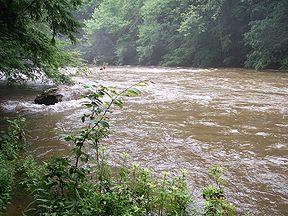.gif)
Cranberry River (West Virginia)
Encyclopedia

Tributary
A tributary or affluent is a stream or river that flows into a main stem river or a lake. A tributary does not flow directly into a sea or ocean...
of the Gauley River
Gauley River
The Gauley River is a river in West Virginia. It merges with the New River to form the Kanawha River, a tributary of the Ohio River. It is one of the most popular advanced whitewater runs in the Eastern United States and is the chief feature of the Gauley River National Recreation Area.-Headwaters...
located in southeastern West Virginia
West Virginia
West Virginia is a state in the Appalachian and Southeastern regions of the United States, bordered by Virginia to the southeast, Kentucky to the southwest, Ohio to the northwest, Pennsylvania to the northeast and Maryland to the east...
, USA. It is a part of the Mississippi River
Mississippi River
The Mississippi River is the largest river system in North America. Flowing entirely in the United States, this river rises in western Minnesota and meanders slowly southwards for to the Mississippi River Delta at the Gulf of Mexico. With its many tributaries, the Mississippi's watershed drains...
watershed, by way of the Gauley, Kanawha
Kanawha River
The Kanawha River is a tributary of the Ohio River, approximately 97 mi long, in the U.S. state of West Virginia. The largest inland waterway in West Virginia, it has formed a significant industrial region of the state since the middle of the 19th century.It is formed at the town of Gauley...
, and Ohio
Ohio River
The Ohio River is the largest tributary, by volume, of the Mississippi River. At the confluence, the Ohio is even bigger than the Mississippi and, thus, is hydrologically the main stream of the whole river system, including the Allegheny River further upstream...
Rivers, draining an area of 74 square miles (192 km²).
The river has also been known historically as Cranberry Creek.
Geography
The Cranberry River is formed in southwestern Pocahontas CountyPocahontas County, West Virginia
As of the census of 2000, there were 9,131 people, 835 households, and 527 families residing in the county. The population density was 10 people per square mile . There were 7,594 housing units at an average density of 8 per square mile...
by the confluence of its North and South forks. The South Fork, the longer of the two at a length of 9 miles (14.5 km), rises on Cranberry Mountain just west of the Highland Scenic Highway before flowing through the Cranberry Glades Botanical Area
Cranberry Glades Botanical Area
Cranberry Glades — also known simply as The Glades — are a cluster of five small, boreal-type bogs in southwestern Pocahontas County, West Virginia, USA. This area, high in the Allegheny Mountains at about , is protected as the Cranberry Glades Botanical Area, part of the Monongahela National Forest...
. The North Fork rises about 2 miles (3.2 km) north on Black Mountain.
Below the confluence of its forks, the Cranberry flows for 24 miles (38.6 km) generally westward towards its mouth at the Gauley River
Gauley River
The Gauley River is a river in West Virginia. It merges with the New River to form the Kanawha River, a tributary of the Ohio River. It is one of the most popular advanced whitewater runs in the Eastern United States and is the chief feature of the Gauley River National Recreation Area.-Headwaters...
near Craigsville
Craigsville, West Virginia
Craigsville is a census-designated place in Nicholas County, West Virginia, United States. The population was 2,213 at the 2010 census.-Geography:Craigsville is located at ....
.
Since the river flows mostly through United States Forest Service
United States Forest Service
The United States Forest Service is an agency of the United States Department of Agriculture that administers the nation's 155 national forests and 20 national grasslands, which encompass...
land, no more than a handful of people live along its banks; the few that do reside near the mouth of the river. However, the Cranberry River has several pay campgrounds, free campsites, and picnic areas along its banks.
Fishing
The Cranberry River and its small tributaries are regarded as some of the finest troutTrout
Trout is the name for a number of species of freshwater and saltwater fish belonging to the Salmoninae subfamily of the family Salmonidae. Salmon belong to the same family as trout. Most salmon species spend almost all their lives in salt water...
streams in the eastern United States. Until recently, however, trout fishing
Fishing
Fishing is the activity of trying to catch wild fish. Fish are normally caught in the wild. Techniques for catching fish include hand gathering, spearing, netting, angling and trapping....
on the south fork was limited to the lower half of the river due to acid rain. The West Virginia Division of Natural Resources has worked to counter this problem by installing a liming
Lime (mineral)
Lime is a general term for calcium-containing inorganic materials, in which carbonates, oxides and hydroxides predominate. Strictly speaking, lime is calcium oxide or calcium hydroxide. It is also the name for a single mineral of the CaO composition, occurring very rarely...
station on the north fork of the river.

